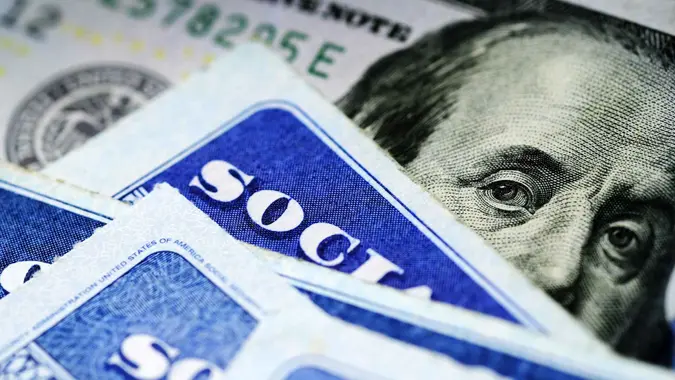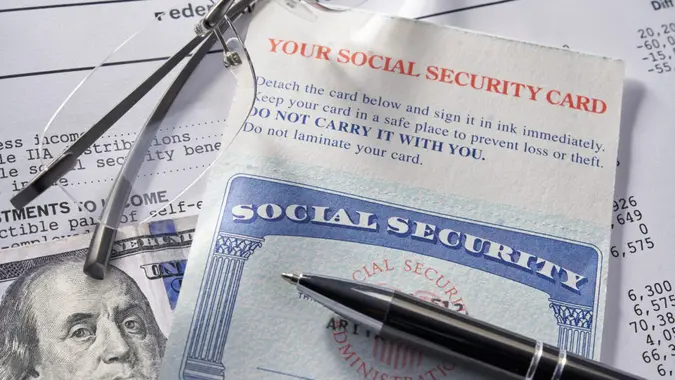6 Ways To Create a Flexible Retirement Plan for Changing Circumstances

Commitment to Our Readers
GOBankingRates' editorial team is committed to bringing you unbiased reviews and information. We use data-driven methodologies to evaluate financial products and services - our reviews and ratings are not influenced by advertisers. You can read more about our editorial guidelines and our products and services review methodology.

20 Years
Helping You Live Richer

Reviewed
by Experts

Trusted by
Millions of Readers
While it’s important to have a clear plan for your retirement, many things can complicate or change the vision you have laid out for yourself, from health issues to relocating.
The best strategy is to prepare financially in a way that leaves you flexible to changing possibilities and for any eventuality.
Shawn Scott, a financial advisor and senior vice president with Wealth Enhancement Group, explains six ways to do this.
Diversify Your Assets
Diversification can be a bit of a buzzword in investing, Scott acknowledged, but it’s an important one. While it’s most commonly used in reference to having an investment portfolio that is spread across assets like stocks and bonds, he said, “The reality is diversification can mean a lot of different things.”
What it ultimately means is that you shouldn’t be putting all, or too much, of your savings in one basket, he advised. Put enough in your 401(k) to capture an employer match, or in an IRA to save on those pretax dollars, but remember, too, “You lose all flexibility when your money is in a pre-tax account because it’s taxed as income when that money comes out,” Scott said.
Be Careful About Distributions
You also want to be careful to set up your retirement accounts in such a way that it minimizes your tax liabilities. Depending on how you’re invested, taking distributions from an IRA could bump your tax bracket up and impose taxes on your Social Security benefits or affect the cost of your Medicare premiums.
“So having all of your money in that pretax bucket and paying tax on it later, although good for saving, creates additional challenges when you go to get the money out,” Scott said.
Invest Most of Your Funds in a Roth IRA
This is why Scott advises that everyone should invest the bulk of their retirement savings in a Roth IRA, which provides tax-free growth.
“The benefits are almost incomprehensible for most because the compounding effect of that tax-free growth makes the account worth considerably more since you’re not paying taxes coming out,” he said.
It also allows you to customize your withdrawal strategy in retirement to manage tax efficiency, he explained.
“So if you’re getting Social Security and you need X amount of dollars per month to live on, you can say, OK, well I’m going to take this amount from my pretax bucket and this amount from my Roth bucket. That way some of your money is coming out tax-free.”
By taking less money from your “taxable bucket,” (aka your 401(k) plan), “It gives you flexibility and so you can then manage those distribution strategies in retirement.” Thus, if you need extra money for a medical issue, a home repair or a new vehicle, to name a few, he said you have more options that will have the least harmful effect on taxing your other forms of income.
When it comes to the Roth accounts, he feels “You can’t err on the side of too much in a Roth.”
While 401(k) plans are good when you get an employer match, otherwise, they will ultimately be taxed at distribution time.
Emergency Savings Are Key
Another obvious but important tip, he said, is to have some amount of emergency savings (though ideally three to six months’ worth of expenses).
“If you want flexibility, then one of the best things you can do is not have to go to a retirement account to get those dollars,” he stressed.
Taking money from a savings account makes things much less financially complicated, he said, “Because that money is already sitting in cash available for you to use for whatever you want, and there’s no tax implication to take that money.”
Use a Health Savings Account Properly
When it comes to healthcare costs, he suggested that people with high deductible health plans utilize health savings accounts (HSAs) properly, which is to say, put more funds in them than you think you might use so you can grow those funds over time as well.
Instead, he sees people putting in only as much as they expect to spend in that given year for the sake of the tax deduction.
“What people don’t often understand is that health savings accounts can accumulate and grow. It’s not a use it or lose it like the old flexible spending accounts. So if you max fund your health savings account while you’re working, even if you’re healthy and are not using that money for medical expenses, now you can continue using that for future medical expenses, even in retirement.”
Once you’re in retirement, you can use HSA funds to pay for your medical expenses, which means you don’t have to draw from your actual retirement accounts for those expenses, he explained.
“Medical expenses were the most expensive parts of retirement. Fidelity says the average retiree will spend $250,000 over their retirement years on medical expenses. And so [it’s important to] have a pool of money to draw from that is tax-free.”
Stay Active
Though not explicitly related to finances, Scott also pointed out that it’s important to have a plan for your time and activity in retirement, for your mental and physical health (which has healthcare cost implications), because people often forget to consider the psychological implications of retirement.
“So not exercising the body, not exercising the mind has terrible implications,” he said.
So have a plan, he recommended, for what you’ll do with your non-working time. It not only keeps you healthier, “it saves your loved ones a lot of burden and stress as well.”
With these strategies in place, you can hopefully have a comfortable retirement that adapts to the unexpected.
 Written by
Written by  Edited by
Edited by 

























